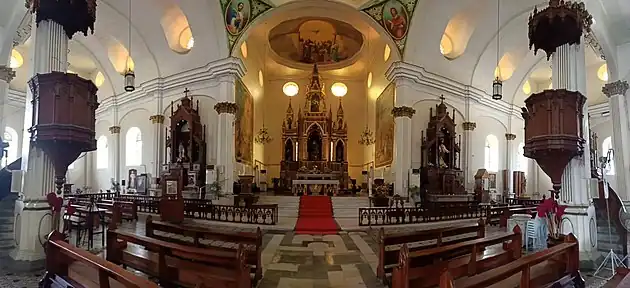Molo Church
Molo Church, also known as Saint Anne Parish Church, is a neogothic Roman Catholic church located in the district of Molo in Iloilo City, Iloilo, in the Philippines. The church is recognized as "the women's church" or "the feminist church" because it only features images of female saints inside, including Saint Anne, the patron saint of Molo. The National Historical Institute declared it a national landmark in 1992.
| Molo Church | |
|---|---|
| Saint Anne Parish Church | |
.jpg.webp) The church in January 2023 | |
.svg.png.webp) Molo Church .svg.png.webp) Molo Church | |
| 10°41′50″N 122°32′41″E | |
| Location | Molo, Iloilo City, Iloilo |
| Country | Philippines |
| Language(s) | Hiligaynon, English |
| Denomination | Roman Catholic |
| History | |
| Status | Parish church |
| Founded | 1831 |
| Dedication | Saint Anne |
| Consecrated | 1888 |
| Architecture | |
| Functional status | Active |
| Heritage designation | National Historical Landmark |
| Designated | 1992 |
| Architectural type | Church building |
| Style | Gothic-Renaissance |
| Groundbreaking | 1831 |
| Completed | 1888 |
| Specifications | |
| Length | 82.1 m (269 ft)[1] |
| Width | 28.7 m (94 ft)[1] |
| Width across transepts | 48.6 m (159 ft)[1] |
| Other dimensions | Façade facing southwest |
| Number of domes | 1 |
| Number of towers | 2 |
| Materials | Coral, Limestone |
| Administration | |
| Archdiocese | Jaro |
| Deanery | Saint Paul |
| Parish | Saint Anne |
| Clergy | |
| Priest(s) | Very Rev. Msgr. Maurillo P. Silva, Jr., P.C. |
History
Molo Church was constructed in 1831 under Fray Pablo Montaño.[2] Originally made of tabique pampango with a chalk roof. Plans for a concrete structure were drawn up in 1866, approved by Bishop Mariano Cuartero in 1869, and completed in 1888 by Fray Agapito Buenaflor under Don Jose Manuel Locsin's supervision. In honor of Saint Anne, the church is known as a feminist church because of its two rows of sixteen female saints on both sides of the altar.[3]
Molo Church was visited by Dr. Jose Rizal on August 4, 1886, because of its biblical paintings, which can no longer be seen in the church.[3]
It served as an evacuation center for civilians during World War II. The church was damaged and one tower was destroyed on March 18, 1945, during the liberation of the Philippines from Japan. The church was later repaired by Rev. Manuel Alba with the help of the congregation.[4]
The church was declared a national landmark by the National Historical Institute in 1992 through the representation of Sir Knight Rex S. Salvilla. It is the only Gothic church in the country outside of Metro Manila.[4]
Architecture
The façade of the church is made of rough stone that highlights the Gothic-Renaissance Revival elements seen in the structure, with its two towers that have numerous spires and pointed arches. The church has three naves with sixteen statues of female saints inside. These saints are Saint Marcella, Saint Apollonia, Saint Genevieve, Saint Isabelle, Saint Felicity, Saint Agnes, Saint Monica, Saint Magdalene, Saint Juliana, Saint Lucy, Saint Rose, Saint Teresa, Saint Clare, Saint Cecilia, Saint Margaret, and Saint Martha.[5]
The church has four wooden side altars and a single high altar. The church's patroness, Saint Anne, is housed in the reredos at the high altar, along with statues of the Blessed Virgin and the Holy Trinity.[4][5]

_2022-07-06.jpg.webp)
Gallery
 View of the church from the Molo Plaza
View of the church from the Molo Plaza Close-up view of the façade
Close-up view of the façade Convent of Molo beside the church
Convent of Molo beside the church Dome interior
Dome interior The Ten Commandments in Hiligaynon language
The Ten Commandments in Hiligaynon language Side view of the church
Side view of the church A sculpture of one of the sixteen female saints inside the church
A sculpture of one of the sixteen female saints inside the church.jpg.webp) Northwest façade
Northwest façade National Historical Commission of the Philippines (NHCP) historical marker
National Historical Commission of the Philippines (NHCP) historical marker Interior facing northwest
Interior facing northwest Another historical marker
Another historical marker High altar and reredos
High altar and reredos
References
- Measured using Google Earth.
- "MyGuide.ph, Author at MyGuide.ph". MyGuide.ph. Retrieved July 10, 2022.
- ExploreIloilo.com. "Molo Church: A feminist church in the Philippines". Explore Iloilo. Retrieved July 10, 2022.
- "Molo Church: Historical and Religious legacy of Molo". Vigattin Tourism (ARTICLES) - Philippines. Retrieved July 10, 2022.
- "Molo Church". Guide to the Philippines. Retrieved July 10, 2022.
External links
 Media related to Molo Church at Wikimedia Commons
Media related to Molo Church at Wikimedia Commons

